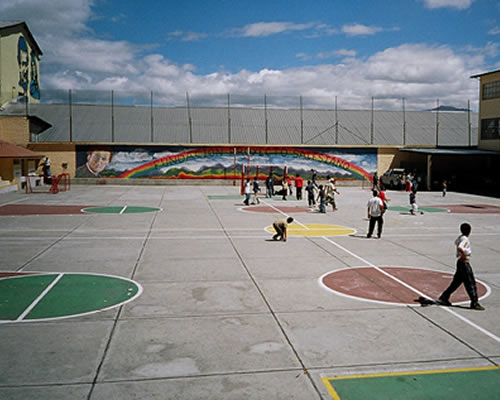by
Murray Tong
(Guelph, Jan 7, 2005)
As they weave their darkened paths home, the outgoing bar patrons and early morning prowlers don’t pay much attention to young girls selling flowers on the street. For them, it’s just another part of the after-hours world of Quito, Ecuador’s capital and second-largest city.
Young children living and working in the streets are an all-too-common sight in many other cities around the world. But for University of Guelph graduate student Vicky Maldonado, who visited Quito six years ago, it was shocking. Now, she’s surveying these street youth about their survival strategies and the social and economic issues they face, to learn more about their lives and help them get off the streets.
|

Children play at La Tola School in Quito, Ecuador, a Roman Catholic school established by the Salesian order. La Tola is one of several Ecuadorian schools that offers special classes and medical services to the city’s street youth.
Photo: Vicky Maldonado
|
“There are so many children out there who don’t have a childhood because they’re working when they’re so young,” says Maldonado, who’s studying with Prof. Bill O’Grady in the Department of Sociology and Anthropology. “I thought to myself: ‘How can the government, or anyone else, accept the fact that there are children on the street?’”
After developing an 80-question survey with O’Grady, Maldonado returned to Ecuador – the country of her parents’ birth – this past summer to hear the stories of these Ecuadorian street children, how they got there and what they’re doing to cope. She will use the information she’s gathered to compare these experiences to those of Toronto street youth, to see what parallels exist between the street youth of two different continents. From there, she and O’Grady hope to make recommendations to assemble better social policies and outreach programs that can address specific issues to help alleviate this worldwide problem.
Maldonado originally thought it would be difficult to coax answers from the street youth. But she found that most of the interview subjects were co-operative and willing to have their stories heard.
“I didn’t have to ask the youth to do the survey – they were eager to do it,” she says. “They even thanked me for the opportunity to speak. For them, the reward was that someone cared, that someone listened.”
That was different from their normal day-to-day existence, far from their homes. In many cases, impoverished young people come from rural highlands to Ecuador’s major cities, to find greater opportunities for themselves and their families. Some come down from the mountains with vegetables and foodstuffs to sell in the markets. But if their homes are too far away, very often they can’t return at night. Instead, they must stay on the streets.
It isn’t so different from the plight of many street youth in Canadian cities such as Toronto, says Maldonado. She believes they are among the victims of the widening gap between rich and poor that plagues the entire world, and hits Latin America particularly hard.
“There’s more of a cycle-of-poverty effect in Ecuador,” says Maldonado. “It’s not as easy as many people think to get off the streets. It’s more than a change of clothes.” Most of these street youth, she adds, don’t make enough money to get themselves or their families off the streets.
There’s also a significant difference – one that’s not always apparent – between the individual street children. In Ecuador, they’re divided into two rough groups: niños en la calle (children in the street), who work in the streets for meagre wages but are able to go home at night, and niños de la calle (children of the street), who work and live on the streets. Maldonado is also examining the issues and problems confronting each these groups, to get a broader perspective on how kids from different backgrounds deal with street life.
But despite the problems she sees, Maldonado says there’s hope. She’s noticed significantly fewer children living on the streets than she saw six years ago. And for the most part, she’s also found that children have an easier time coping on the streets than adults, because they’re adaptable and become quickly accustomed to street life, remaining logical about why they work there. In fact, she observed that many of the children live busy, varied lives, often working in the mornings, then putting on school uniforms and attending classes in the afternoons.
The street youth receive some help from agencies and organizations, such as the Salesianos (the Salesian Order), an international Roman Catholic organization that builds Catholic schools around the world. One of their schools in Ecuador, La Tola School in Quito, holds classes in the afternoon to allow students to work in the mornings, and also offers medical and dental services as well as special education for children who have never attended school.
Organizations like the Salesianos make a huge difference in many children’s lives, but they must continue to grow and expand their services. By learning more about the experience of street youth in different parts of the world, Maldonado and O’Grady hope to be able to learn more about how street youth got to where they are, how they cope – and find more effective ways to reach out to them.
“This type of research has to get back to the people you’re studying,” says Maldonado. “Hopefully, it will benefit these street children in the form of better social policy and improved outreach program services.”
This research was funded by an International Field Studies Grant from the University of Guelph’s Centre for International Programs and the Richard and Sophia Hungerford Graduate Scholarship.
-30-

